
10 minute read
Return of the Peregrine.................................................Andrew Easton
Having no previous involvement with any local natural history organisations, my personal introduction to SOG came just before Christmas in 1976. I was fishing for flounders along the Orwell, just about where the Orwell Bridge crosses the river today, when a Great Northern Diver swam past. I was thrilled with my sighting and was wondering who I should tell when a young man, sporting a pair of binoculars, walked past wheeling his bicycle. It was Philip Murphy. I told him of my find, but was soon deflated when he said, “it’s still here then”. Philip told me about SOG, which I joined later that day and was soon recruited to the Editorial team whose main role was to check the systematic list prior to it going to print. The team then met in West Suffolk and we spent many an evening at Roger and Pam Walton’s house discussing records; rarely did we get home before midnight. Putting the bulletin together was a monumental task. Each issue was typed onto a stencil, run off using an old Gestetner printer, and then the printed foolscap pages stapled together. Eventually, it was realised that six issues a year was too much, so a revamped quarterly bulletin, now A4 and stapled in the middle, was introduced in the 1980s. So The Harrier was born, a change that coincided with the merging of the two branch Committees.
SOG publications and books The Group has organised many species-specific bird surveys such as those for the Rook, Cuckoo, Ringed Plover and Tufted Duck, and administered two county raptor surveys. Our publications include: The Rook in Suffolk by Mike Jeans and Reg Snook (1976), Birds of Prey in Suffolk 1973-1978 by Alan Paine (1980) and Survey of breeding raptors and owls in Suffolk 1995-1998
Andrew Easton
The return of the Peregrine to Lowestoft
by Mick Wright (2001). There have been two editions of Easy Birdwatching – a book designed to help those less mobile to find easy access to birdwatching sites in Suffolk. Nowadays, local survey work focuses on studies instigated by the BTO and the pages of The Harrier are used to promote work on national surveys locally. Mick Wright has been both SOG Project Officer and BTO Representative for over 25 years, a remarkable contribution to Suffolk ornithology.
SOG helps to found LBO The Group was instrumental in the founding of Landguard Bird Observatory (LBO) in 1982, when it also became more active in the field of nature conservation. It protested loudly about the loss of wildlife habitats, particularly on the Orwell Estuary, and its biggest battle was its fight to save the Fagbury mudflats and marshes. The Felixstowe Dock and Railway Company announced that they were seeking to expand the Port of Felixstowe westwards up the Orwell Estuary and as a Group we were to fight this tooth and nail. We assisted LBO in gathering vital information on the birds that frequented this part of the Estuary and sent a representative to the Enquiry in the House of Lords, which was myself (after enrolling as a Parliamentary Agent). We may have lost this battle, but Trimley Marshes Nature Reserve and Levington Lagoon are testimonies to our efforts to look after wildlife on the Orwell.
Your Council will be looking at ways to celebrate our Ruby Jubilee with a series of events, so watch these pages and those on our website for further announcements.
Steve Piotrowski, Honorary President
A pair of Peregrines is recorded as having bred regularly in the tower of Corton Church in the early 1800s, although exact dates are unknown. But each year a local falconer, John Dawson Downes from Gunton, took the young reared by them. So, with an effective productivity of zero, it was no great surprise that the species didn’t become established in the area at that time.
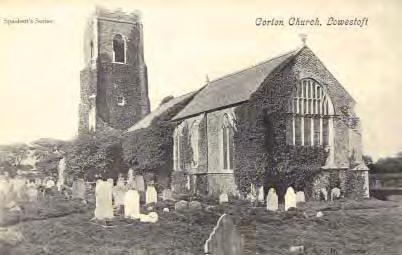
Corton Church - the original Suffolk Peregrine nest site As all SOG members know, it was not until 2008 that Peregrines bred successfully again in Suffolk, on the Orwell Bridge on the outskirts of Ipswich, their initial attempt in 2007 having failed. 2009 The story of the return of the Peregrine as a breeding bird to the Lowestoft area began on December 19th 2009 when, at dusk, one was noted flying south westward over Tonning Street in central Lowestoft.
2010 In January 2010 it became clear that a first winter bird had taken up residence in the town, primarily frequenting the Commercial Road grain silo and a rig module then under construction in the SLP yard in Lowestoft harbour. It also used the old container crane along the North Quay (until it was dismantled). Once the rig module left SLP, the grain silo became its main residence. There was no doubt that this was the bird seen hunting over Corton Wood and the adjacent beach area on January 8th, where the local Sparrowhawks sallied out of the wood to mob it.
1st winter Peregrine - Lowestoft - January 2010 Without another Peregrine to compare it with, size was difficult to judge, so there was debate over whether it was male or female.

In anticipation of the bird staying and eventually attracting a mate, permission was sought from the grain silo owners (then Plasmor, now Dudman Group) to place a nest box on the silo. Permission being granted, a collection was made amongst our birding group and a wooden nest-box was built and placed on the top of the silo on February 18th.
Having read that Peregrines can breed from two year’s old, we realised that 2011 would be the very earliest we could hope for a breeding attempt to be made by this bird, should a mate turn up; and so the long wait began. The Peregrine remained around the harbour and Lake Lothing area of central Lowestoft throughout the whole of 2010 and into 2011, and sightings at Carlton Marshes and Oulton Broad throughout this period were no doubt also of this individual.
2011 Hopes were raised when two were seen together around the grain silo in February 2011, only to be dashed when they proved to be the same sex (judged by being identical in size and build); but at least another Peregrine had found the area suitable, which was very encouraging. This second bird, a first winter/summer, was still around in April 2011, though it was not seen after this.
Herring Gulls - Lowestoft - summer 2011 Squatters in the ‘des res’ penthouse suite
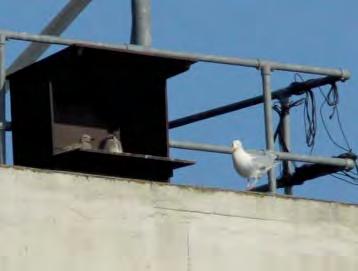
The nest-box did get its first use in 2011, albeit not by its intended occupants. A pair of Herring Gulls started showing a lot of interest in this ‘des res’ penthouse and went on to successfully raise one youngster there. Their chick was colour-ringed and has been seen subsequently at Mutford in August 2011, at Wangford landfill site in November 2011 and at Leathes Ham in December 2012.
2012 The year started with just the one Peregrine, now apparently resident, and coming up to the age of three, a more typical age of first breeding. All we needed now was a mate to arrive.
On March 17th it was joined at the grain silo by a second bird, however this proved to be not only a first summer bird, but again the same sex. The following day an adult Peregrine was spotted on the radio mast of Lowestoft Police station and this appeared to be smaller than the other two birds. Had a mate finally arrived?
On March 24th this smaller bird, clearly an adult male, was seen at the grain silo with the resident adult, now demonstrably a female, and accompanied by a first summer female. The male was seen to be colour-ringed, but it would take until April 12th before the bird sat in a location enabling the ring to be successfully read. Then we discovered he had been ringed ‘BP’ as a chick on the Orwell Bridge, Ipswich in May 2010.
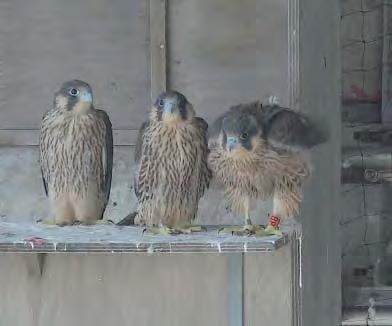
‘BP’ on the Orwell Bridge nest in 2010 Peregrine (male) - Lowestoft - summer 2012 His orange plastic ring coded BP, partially visible here in this digiscoped shot
Peregrine (male) - you can just make out the ‘B’ of ‘BP’ in the inset
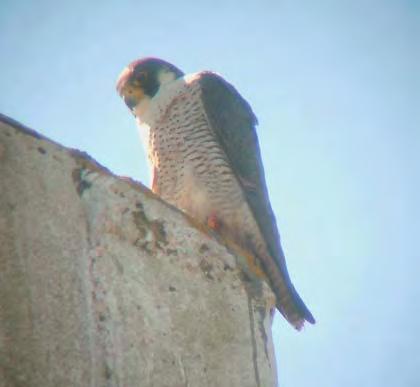
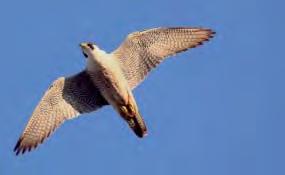
We finally had a pair of Peregrines of breeding age (only just in the case of the male), but it was now nearly April and most of the Peregrines in southern Britain already had clutches of eggs. Was it too late for a breeding attempt in 2012?

Peregrine (female) - Lowestoft - summer 2012 The female is un-ringed so her origin is unknown
Luckily in early April the couple were soon seen displaying and mating and, from their behaviour, by the end of April it was clear the female was sitting on an unknown number of eggs. Another wait began.
First breeding attempts have a high failure rate due to inexperience, and late broods also fare poorly as well; as this attempt met both criteria we didn’t have great expectations of success.
However the pair proved us wrong and, on the late May Bank Holiday weekend, from their behaviour it became clear that an egg had hatched and they were feeding a chick. A visit by a suitably licensed ringer was arranged for early June to check on progress and ring any young. The visit proved that they had indeed hatched a chick, but there was no sign of any other eggs. Perhaps being a first breeding attempt by young birds and, compounded by a late start, the female may have only laid one egg this time? Unfortunately by mid-June their behaviour changed again and they were no longer visiting the nest box regularly, nor taking food in at all. A subsequent visit to the box revealed it was empty, with not even the expected dead chick there.
Without a webcam we can never be sure of its fate, but at least one Herring Gull was regularly present nearby, and had been seen on the roof of the box and walking along the edge of the roof past its front. Once both adults were out hunting perhaps a lone small chick proved too tempting a target? This behaviour change also followed the westerly gales, with the cold and torrential rains of June; and, although westerly facing, the raised lip at the front of the box should hopefully have prevented it falling, or even being blown out of the box whilst at that early stage.
2013? Both adults were still present at the end of July 2012, and a colour-ringed female (possibly from Cornwall) was also present for at least one day in late September. The original female at least was still around in December 2012. The latest news is that from February 26th two birds, apparently a pair, have been seen together around the grain silo again. Finally on the evening of March 7th both birds were again together, calling frequently, and then the following morning, before the male left to hunt, a ‘handy’ stretch of its leg proved it was indeed ‘BP’.
But nothing is ever totally straightforward. A pair of Herring Gulls is also still showing interest in the ‘Peregrine’ box - on the first weekend in March both were sitting on the roof and its front sill, so once again this year there is competition for the box.
Nevertheless, we remain hopeful that in 2013 this pair may succeed in fledging the first Peregrines in the Lowestoft area for 200 years. We’ll keep you posted!
Peregrines chick - Lowestoft - summer 2012 The first Peregrine chick hatched in the Lowestoft area for c.200 years. It appears that one of its meals was probably a Redshank judging by the leg to the left and in front of it











